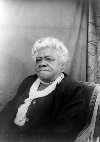 Founded in 1944 by Frederick D. Patterson and Mary McLeod Bethune, the United Negro College Fund (UNCF) provides college tuition for African-American students and scholarship funds for its approximately 40 member colleges. Many of its beneficiaries are the first in their families to attend college, and it counts many distinguished individuals among its alumni, including Martin Luther King, Jr. The UNCF motto is one of the most well known slogans in the history of advertising. What is it? Discuss
Founded in 1944 by Frederick D. Patterson and Mary McLeod Bethune, the United Negro College Fund (UNCF) provides college tuition for African-American students and scholarship funds for its approximately 40 member colleges. Many of its beneficiaries are the first in their families to attend college, and it counts many distinguished individuals among its alumni, including Martin Luther King, Jr. The UNCF motto is one of the most well known slogans in the history of advertising. What is it? Discuss
Source: The Free Dictionary
 The
The  Appel was a Dutch painter and sculptor and co-founder of the abstract expressionist group COBRA, whose members hailed from Copenhagen, Brussels, and Amsterdam. Active from 1948 to 1951, the group created work featuring primary colors and spontaneous brushwork. Appel’s own style was characterized by violent color and crude, reductive figures. Later in life, he turned to creating figurative sculptures in wood and metal. What was done to censor Appel’s controversial fresco in Amsterdam City Hall?
Appel was a Dutch painter and sculptor and co-founder of the abstract expressionist group COBRA, whose members hailed from Copenhagen, Brussels, and Amsterdam. Active from 1948 to 1951, the group created work featuring primary colors and spontaneous brushwork. Appel’s own style was characterized by violent color and crude, reductive figures. Later in life, he turned to creating figurative sculptures in wood and metal. What was done to censor Appel’s controversial fresco in Amsterdam City Hall?  The Horae, whose name literally means the “Hours,” are three goddesses in Greek mythology who are said to control orderly life. Traditionally, there are thought to be two generations, or sets, of Horae: Thallo, Auxo, and Carpo—the goddesses of spring, summer, and autumn—and Eunomia, Dike, and Eirene, charged with maintaining the stability of society. In addition, there are the 12 tutelary goddesses also called hours, each of which presides over an hour of the day. Who parented the Horae?
The Horae, whose name literally means the “Hours,” are three goddesses in Greek mythology who are said to control orderly life. Traditionally, there are thought to be two generations, or sets, of Horae: Thallo, Auxo, and Carpo—the goddesses of spring, summer, and autumn—and Eunomia, Dike, and Eirene, charged with maintaining the stability of society. In addition, there are the 12 tutelary goddesses also called hours, each of which presides over an hour of the day. Who parented the Horae?  Milton Hershey, founder of the Hershey Chocolate Company, originally created Hersheypark for his employees. Situated along a creek, it was a good spot for boating, picnicking, and enjoying baseball, which is what visitors did on the park’s first day in 1907. The next year, the park added its first ride, a carousel. Over the decades, as the park expanded, it grew from a regional amusement to a national attraction. In what year did it bring the first looping roller coaster to the East Coast?
Milton Hershey, founder of the Hershey Chocolate Company, originally created Hersheypark for his employees. Situated along a creek, it was a good spot for boating, picnicking, and enjoying baseball, which is what visitors did on the park’s first day in 1907. The next year, the park added its first ride, a carousel. Over the decades, as the park expanded, it grew from a regional amusement to a national attraction. In what year did it bring the first looping roller coaster to the East Coast?  Among rural people in
Among rural people in  A onetime screenwriter, Grafton began writing detective novels after a bitter and protracted custody battle left her daydreaming about the vengeful crimes she would have liked to commit but could not. As a means of escape, she created private detective Kinsey Millhone, the protagonist in a series of alphabet-titled novels such as A is for Alibi and B is for Burglar. After G Is for Gumshoe, she was able to quit screenwriting. Why won’t she sell the film rights to her books?
A onetime screenwriter, Grafton began writing detective novels after a bitter and protracted custody battle left her daydreaming about the vengeful crimes she would have liked to commit but could not. As a means of escape, she created private detective Kinsey Millhone, the protagonist in a series of alphabet-titled novels such as A is for Alibi and B is for Burglar. After G Is for Gumshoe, she was able to quit screenwriting. Why won’t she sell the film rights to her books?  Radiocarbon dating is a method for determining the age of carbonaceous materials—especially ancient archaeological specimens—that relies on the presence of a naturally occurring isotope called carbon-14. After an organism dies, the amount of carbon-14 in its remains gradually decreases through radioactive beta decay. Measuring the amount of carbon-14 in an organism’s remains thus allows scientists to determine how long it has been dead. How do atomic bombs affect atmospheric carbon-14 levels?
Radiocarbon dating is a method for determining the age of carbonaceous materials—especially ancient archaeological specimens—that relies on the presence of a naturally occurring isotope called carbon-14. After an organism dies, the amount of carbon-14 in its remains gradually decreases through radioactive beta decay. Measuring the amount of carbon-14 in an organism’s remains thus allows scientists to determine how long it has been dead. How do atomic bombs affect atmospheric carbon-14 levels?